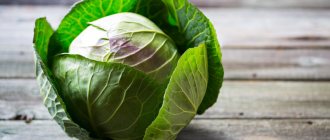In autumn it is time to prepare food for the winter. Cabbage occupies a special place. It is healthy, tasty and affordable. Sauerkraut will become a frequent guest on the table if all preparation conditions are correctly met. It is eaten not only as a separate dish, but also used in the preparation of other dishes.
Sauerkraut with lingonberries
If you are going to start making pickles at home, then find out how long it takes to ferment cabbage at room temperature. My tips will help you choose a variety, recipe, dishes for the product, as well as storage space.
When to start cooking
Our grandmothers also tried to ferment cabbage in the fall or winter - it all depended on the variety. For mid-season varieties, it is permissible to start fermenting in September. They cannot be left in the storage room. It is better to put the finished product in the refrigerator.
Cabbage heads of different sizes and colors
It is better to ferment mid-late varieties with the onset of the first frost. Their peculiarity is that by the time they ripen, the amount of sugar in cabbage leaves increases. As a result, the taste of the finished cabbage is significantly improved.
There are also late varieties. They can be stored fresh for several months. The heads of cabbage themselves cannot withstand long-term storage, so they are sent for processing 2-3 months after collection. During this period, the leaves accumulate sugar, which contributes to the appearance of juiciness.
Do not ferment late varieties ahead of schedule. There is a possibility of receiving a product with bitterness and an unappetizing odor.
If you strictly follow my advice, you will get excellent sauerkraut.
Benefit
You can eat different types of cabbage: red and white cabbage, Brussels sprouts and Savoy, broccoli and Peking cabbage, cauliflower and many other varieties. A wide variety of dishes can be prepared from this vegetable , but sauerkraut is considered the leader in this menu. This is a very tasty product that can be consumed as an independent dish or used as a side dish for meat dishes. Pickled vegetables are used to make fillings for pies, pancakes, dumplings, etc.
In winter, such a product is an indispensable source of vitamin C. In addition, the vegetable contains the most important microelements for the human body - zinc, iodine and magnesium . It helps regulate metabolism and normalizes intestinal microflora, enriches the body with valuable enzymes and microorganisms.
Traditional medicine recommends using sauerkraut for various ailments. With its help, healers cure not only the common cold, but also such serious diseases as bronchial asthma and even epilepsy. The pickled vegetable helps with vitamin deficiency, fever, gastritis, hemorrhoids, burns, cuts, insect bites. It is indispensable for heartburn, liver disease and other diseases.
As scientists have found, sauerkraut has specific substances that can stop the growth of cancer cells. This is especially true in the case when malignant neoplasms form in the intestines, lungs, and mammary glands . In addition, pickled vegetables restore male strength.
Which variety to choose for pickling
According to Russian tradition, any family can make sauerkraut. It doesn’t matter whether you live in your own house, where there is a vegetable garden, or in an apartment, in winter you have pickles on your table. It is important to understand the variety of cabbage in order to enjoy eating it.
Cabbage, pickled according to standard recipe
Don't buy early varieties. They are not at all suitable for sourdough. It is better to take a variety that ripens closer to winter. This type of cabbage has denser leaves. Take large heads of cabbage with a tight fork - white in cross section. Greenish leaves do not contain the required amount of sugar. White cabbage leaves are ideal for sourdough.
If we talk about a fresh head of cabbage, then choose one that tastes crispy and sweet. When you are going to ferment in late autumn, look carefully at the leaves. They should not be frostbitten.
The best varieties
How much cabbage is fermented depends on the variety chosen.
I suggest you familiarize yourself with the most useful and inexpensive varieties:
- Glory , Gift . The fruit grows up to 5 kg. Ripens in 113 days.
- Jubilee F
- Dubrovinskaya with a fetal weight of 10 kg.
- Belarusian.
- Turkis , Geneva ,
- Amager , Snow White .
The last two are late varieties that are recommended for pickling and long-term storage.
There are connoisseurs of pickled red cabbage. Its peculiarity is a slight bitterness and a hard stalk. If you like this, then you will definitely like it.
Selection of containers
I will tell you further how many days to ferment cabbage, now you need to choose a container. The success of the venture depends on it. A wooden tub is an ideal option. The spruce barrel must first be prepared. To do this, the tub is filled with cold water for a month . It should be changed every five days . This is done to get rid of tannins and resins in the wood.
Sauerkraut in a glass jar
If there are no barrels, feel free to take glass jars. Cabbage pickles very well in them. It is necessary to distribute portions into three-liter containers. The fermentation process goes well in them. As soon as it runs out, you need to put the jar in a cool place. There is no need to rearrange the cabbage.
Ceramics are also suitable for sourdough. It happens that cabbage is fermented even in enamel pans. To prevent toxic substances from getting into the cabbage, you need to carefully inspect the dishes before use. There should be no chips or other damage on it.
So that it crunches
How frustrating it can be sometimes: you try, you do, but in the end, time after time, you end up with some kind of inedible soft mass. Why does cabbage fail? I addressed this question to Maria Maksimenko, Candidate of Agricultural Sciences, leading scientific specialist of the storage and processing department of the Republican Unitary Enterprise "Institute of Fruit Growing"
.
- Not all cabbage can be fermented,
- Maria Grigorievna revealed the secret of failures.
— And the density of the head of cabbage in this case is not the most important indicator.
Cut it open and see how thick the inner leaves are. If the fork is strong and the thin leaves are pressed tightly against each other, most likely the vegetable is only suitable for long-term storage. It doesn't have much juice. Such cabbage will not ferment well and will turn out bitter and tough. If the dense head of cabbage has juicy, thick white-cream leaves, you can safely chop it. Of course, technology is also important. Northern.
The cut heads are placed in salted (50 g of salt per 1 kg of cabbage) boiling water and boiled for 3-10 minutes (to remove bitterness), then cooled. Place pieces of rye bread toasted in the oven, hammered black currant sprigs and dill on the bottom of a dish (wooden or enamel), and layers of cabbage on them, seasoning each layer with spices. Having placed the spices on the top layer, the cabbage is poured with the water in which it was boiled. Cover with gauze and place a wooden circle with pressure on it. After 2-3 days, when fermentation is over, the cabbage is stored in a cold place.
Czech.
Shredded cabbage is ground with salt (up to 20 g per 1 kg of cabbage), mixed with chopped carrots and chopped onions (approximately 30 g and 20 g per 1 kg of cabbage), sprinkled with black peppercorns, bay leaves, placed in a bowl, tamping , and pressed down with oppression.
After 3 days, the cabbage is pierced with a pointed stick to remove the formed gases; after another day, it is squeezed out of the brine and placed tightly in glass jars. Bring the brine to a boil and pour it over the cabbage. The jars are covered with lids, sterilized (liter - 10 minutes, three-liter - 45 minutes) and sealed tightly.
Fast.
You can cook cabbage very quickly if you put it in boiling water before fermenting and keep it until the water boils again. Then remove and immediately plunge into very cold water to cool quickly. Place the cooled cabbage in a colander and let the water drain. After this, ferment it in the usual way. If there is not enough juice, add brine (1 tablespoon of salt per 0.5 liter of boiled water). After 2 days you can eat.
Cucumber.
Is your jar of pickles about to be empty, but there is still plenty of brine in it? It's easier, of course, to pour it out. But it is better to use it for sauerkraut.
So, we chop the cabbage, put it in jars and fill it with brine. There is no need to add any spices or salt - everything is already in it. Leave the containers at room temperature for a day, then close the lid and put them in the refrigerator. In another day, the “cucumber cabbage” will be ready to eat.
Dessert.
To prepare it, plums, pears, peaches, apricots, and hard sweet apples are used. The seeds are removed from the berries, and the fruit is cut into halves or slices. The cabbage is chopped, ground with salt (50-60 g per 4 kg of cabbage), laid in layers interspersed with berries and fruits. Ferment at room temperature for 3-4 days. Then the juice is drained (squeezed by hand or through cheesecloth), boiled, a glass of sugar is added to it, brought to a boil again, cooled and poured into the cabbage. However, the shelf life of such cabbage is limited to two weeks. If it takes longer, the taste will be lost.
"Drunk."
Each layer of cabbage is compacted and poured evenly with a small amount of sweet white table wine. In the future, everything will be the same as in the classic version of fermentation. In fact, you won’t get drunk from such cabbage, but you will undoubtedly appreciate its excellent taste.
It is strictly forbidden to ferment cabbage in aluminum containers. Lactic acid corrodes aluminum, and substances that are extremely undesirable for the body end up in the dish. It is better to use an enameled wide pan or basin - the larger the contact area with air, the better the fermentation process.
If it is not possible to store cabbage in an open container for a long time, transfer it to glass jars and pour vegetable oil on top (two fingers deep). Or canned after pasteurizing for half an hour. If there is not enough brine (and the cabbage should be completely covered with it), add a 2% boiling brine solution.
In the old days it was believed that in order for cabbage to be tasty and crispy, it must be fermented on a new moon. To be softer - in the last quarter. But the full moon is a completely inappropriate time: the cabbage will be too soft and sour.
They also say that cabbage works great if you put it on men’s days - Monday, Tuesday and Thursday.
• Fresh cabbage contains much less ascorbic acid than sauerkraut.
• Cabbage pickled with heads (or halves) retains 1.5-2 times more vitamins than shredded cabbage.
• Pickled cabbage and stored according to all rules has a high vitamin value for 6-8 months.
So why cabbage...
There may be several reasons. Perhaps it was set to sour in the warm season. Or take an early variety - its leaves are always soft. It is possible that along with healthy heads of cabbage there were several frostbitten or overfed with fertilizers. There wasn't enough salt: they added less than 20 g per 1 kg. The fermentation temperature was too high. Or, finally, the air did not escape properly during fermentation.
However, soft cabbage is no different from regular cabbage: its taste, color and smell are the same. And you can eat it.
Sauerkraut “slips” due to excess air, which stimulates the growth of mycelial yeast. These yeast cells are harmless, but they are needed only at the beginning of fermentation and in small quantities. If there are too many of them, putrefactive bacteria begin to actively develop. As a result, the cabbage spoils. Therefore, make sure that it is always covered with brine and does not protrude above it and does not come into contact with the air.
The temperature during fermentation is too low (up to plus 18 degrees). Slightly frozen heads of cabbage. It is possible that they oversalted it. The taste of cabbage also depends on the growing conditions: soil, fertilizers.
Simple cooking method
Choose the right variety. Separate the green leaves and discard them. Usually the top 2-3 sheets . Wash the vegetable and then dry it. For convenience, you need to cut the forks into several parts. Shredding cabbage is easy and convenient with a shredder or a special knife.
Special shredder for cutting cabbage
Place everything that has been chopped into a prepared barrel, tub, jar or pan. They put in one portion and sprinkled it with salt. If you like, use grated carrots, seasonings, cranberries or apples. Place them between layers. Expect that for one kilogram of cabbage you will need about 20 g of salt.
I do not recommend using stalks for sourdough. If you did not grow the cabbage, then most likely a lot of nitrates have accumulated in it.
Compact the chopped leaves well. This is necessary so that the product releases juice quickly. By the way, don’t put a lot of cabbage in the tub. It is necessary to leave some space for liquid and gases to escape.
Adding spices
Gourmets always demand piquant flavor notes and aromas. To give sauerkraut a more interesting smell and aftertaste, you can add juniper berries, caraway seeds or fennel seeds.
Sometimes there are recipes where, in addition to carrots, the composition includes radish or radish. They are not chopped, but grated on a coarse grater. They give sharpness to the product.
Sauerkraut with berries
Do you want to get bright emotions? Add ginger, garlic, pepper or even grapes to the cabbage. It’s not uncommon to add pumpkin and beets to not only change the taste, but also the color.
Lingonberries and cranberries are a traditional addition. The Russian people evoke associations with cabbage among foreigners. If you want to surprise a Western guest, prepare this dish and put it on the table as an appetizer.
Weight and abs
It is wrong to simply chop a head of cabbage and pour brine over all the ingredients. You need to cover the contents with a plate or lid of such a size that it covers only the product, but not the container. A heavy load must be placed on top - oppression. At home, use a jar of water.
A stone, weight or other heavy object will replace the container with liquid. Don't use a metal lid. Iron reacts with brine, which affects the taste of the finished cabbage.
Controlling the fermentation process
Be sure to put the shredded cabbage in a warm place. The room needs a temperature of 18 to 22 degrees . This is the optimal mode for fermentation. Make sure that there is no direct sunlight on the jar.
Gas bubbles come out in the cabbage
To find out whether fermentation has passed, you need to look into the container after three days. If bubbles form on the surface, then the process is progressing. Remove any foam that has collected at the neck of the jar. It is unnecessary and may ruin the product.
Now use a wooden skewer or fork to pierce the cabbage all the way to the bottom. This will release all the gases. If you do not do this, the finished cabbage will have a bitter taste.
What to pay attention to
- Water . The housewife does not always get it right when adding water to a recipe. If you see that too little juice has been released in the first day, then you need to add liquid.
- Bitter taste. I've talked a lot about bitterness, but it can still appear in those who were not careful when choosing a product. Perhaps you did not remove the green leaves that were crushed into the composition.
Salt must be added exactly according to the recipe - Salt.
Not enough salt means your snack is not crispy and soft. If you added too many carrots, the effect may be the same. A vegetable turns out to be tough when salt was added not according to the recipe, and the pressure was applied weakly. Have you noticed that there is mucus on the cabbage? You don’t have to guess for a long time about the reasons for its origin. See if you added iodized salt to the recipe? Sometimes it is released if the vegetable is loaded with chemicals.
- Temperature. If you had to ferment cabbage at low temperatures, a film sometimes appears on the surface of the product. This doesn't mean she's frozen. This layer is just not worth eating.
Suitable company
Other vegetables, as well as fruits, berries and spices added to cabbage, are well fermented, preserved and complement its healing properties. Carrots enrich sauerkraut with carotene - provitamin A. Apples share with it vitamins C and P, as well as chlorogenic acid. Rowan and sweet pepper - vitamin C and carotene. Cranberries and lingonberries contain benzoic acid, which has antimicrobial properties. Spicy plants - bay leaf, cumin, hot pepper, anise - give sauerkraut not only a specific taste and aroma, they contain essential oils and phytoncides, which have a detrimental effect on microbes and stimulate the release of digestive enzymes in our digestive organs.
Cabbage is also sauerkraut with juniper berries - they give it a pleasant specific taste and smell. You can use honey (up to 10 g per 1 kg of cabbage), walnuts, plums, and mushrooms.
Adviсe
Remember the section “notes for the hostess”? There were always tips that made cooking easier. Now I will tell you how to act to avoid mistakes.
It is important to cut correctly and select the proportions of ingredients. If you find a recipe, then don't experiment. Do not deviate from the established proportions. If after tasting you want to add something, then adjust the recipe.
Carrots should be cut as much as indicated in the recipe.
I recommend trying cabbage in tomato juice. This is a great appetizer that will last all season. Cut the cabbage leaves into 6 mm . Do not take the rough parts of the head of cabbage. They do not turn out as juicy and tender as the leaves.
The secret to this recipe is coarse rock salt. It will help fermentation occur within the time frame we need.
Do not touch the cabbage or pierce it with a fork for three days. The gases formed as a result of fermentation will begin to escape on their own, indicating the degree of readiness of the product. Usually the head of cabbage ferments for up to 5 days ; the temperature is +25 °C .
Is it possible to speed up the fermentation process?
This can be done at room temperature. How? We need to remember a little chemistry lessons. If you add more sugar to the tub, the glucose will begin to interact with acids. As a result, fermentation will speed up. Be sure to look at the temperature in the room. The warmer it is, the more efficiently the cabbage ferments.
How many days to ferment cabbage at home
It is a fact that pickles can add variety to the winter table. Our ancestors did everything themselves, so many recipes have been preserved that allow you to make your own pickling. How long does it take to ferment cabbage? At normal room temperature for several days .
How much exactly? It depends on the variety, the amount of salt added to the recipe, container, and temperature conditions.
Sauerkraut is fermented at room temperature for 2 to 7 days.
Storage
Improper storage of cabbage in the cold on the balcony.
The cabbage froze and began to flow. The best place is considered to be a refrigerator, basement, cellar and other cool place. If the tub cannot be removed due to its large size, you will have to transfer the pickles into glass jars. This is the only container that has a beneficial effect on the product.
The temperature that is most suitable for sauerkraut is from 0 to +2 degrees . If the temperature rises, the product loses its elasticity, stops crunching, and becomes covered with mucus. Cabbage can be stored in a barrel for as long as 8 months . In glass jars the period is reduced to six months.
Where can I store it?
To preserve quality and taste, the optimal storage temperature must be maintained at 0...+2°C, while it will be possible to maintain the chemical composition at the level of the end of fermentation. A cool basement or cellar can provide this temperature. If there are no such conditions, then you can store it in the refrigerator or on a glassed-in balcony, or ferment the cabbage in small portions to eat it faster. At elevated storage temperatures, the acidity of cabbage decreases and it loses its elasticity.
Important! As the shelf life increases, the quality of the product deteriorates. Thus, the amount of vitamin C after 7 months of storage is reduced by half from the original content.
What is the best form to eat sauerkraut?
Sauerkraut is good in itself, but this is not its only quality. The product goes well with many vegetables. We suggest combining cabbage with boiled potatoes, fresh and soaked apples, mushrooms, pickled tomatoes and cucumbers, and onions. Many people season it with vegetable oil, which adds piquancy to the taste.
If you decide to prepare the first course or add shredded leaves to the casserole, it is better to rinse them in cold water. This is done so that they do not become even more sour and bitter. The most useful and effective cooking method is heat treatment. You need to set the temperature in the oven to 80-130 degrees and send the pastries with cabbage to cook.
Read the recipe for another nutritious dish in the article “How to cook bulgur correctly.”











